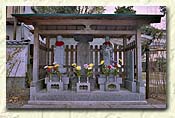
|
‘1.
Image of Jizo Bosatsu (Ksitigarbha Bodhisattva)
An image
of Jizo Bosatsu stands by the past head priests' tombs in
a corner of the graveyard. The image has not worn down or
chipped so much because of the good quality of the stone used.
It is boat-shaped (shaped like the bow of a boat viewed from
above), measuring 85 centimeters or 2.79 feet high and 45
centimeters or 1.48 feet across. The engraved "seed-letter"
ka remains clear and looks beautiful even after the long lapse
of time. The inscription of date reading "March 19, Ninth
year of Tenmei (1789), Year of Hinoe Uma (according to the
Oriental zodiac calendar)" and the inscription of an posthumous
Buddhist name reading "Hoin Eiyo" are both beautiful. The
image of Jizo Bosatsu himself is carved in relief. Part of
his staff with metal rings at the top is chipped off, but
all the rest of the image has not worn down and looks beautiful.
Especially the rich earlobes, the lines of the robe, and his
gentle countenance have the seal of great compassion. It is
really a good image.
|
@ |
|
|
|
@ |
‘2.
Gorinto (Gravestone made up of five stone sections of different
shapes and sizes)
An old-looking gorinto
stands among trees in a corner of the Temple's compound. It
is about 92 centimeters or three feet high. The date engraved
on the base stone reads "April 11, 13th year of Kanei" (1636).
The posthumous Buddhist name reading "Doei Zenjomon" remains
comparatively clear. According to the present head priest,
this must be the name of a past head priest of the Temple.
|
|
 ‘3.
Kasa-Toba (Tablet- or pillar-like gravestone with a cap) ‘3.
Kasa-Toba (Tablet- or pillar-like gravestone with a cap)
A stone gravestone
with a cap (known as kasa-toba) is erected in a corner of
the Temple's compound. It is a square pillar measuring 30
centimeters or about one foot long and wide and 95 centimeters
or 3.12 feet high. Its pedestal is 55 centimeters or 1.8 feet
wide, 70 centimeters or 2.3 feet long, and about 30 centimeters
or one foot high. The cap is about 56 centimeters or 1.84
feet wide, about 31 centimeters or 1.02 feet long, and about
30 centimeters or one foot high. It is an irimoya-style roof
with a Chinese-style gable in the front. A sparrow-shaped
ornament is attached below the lower end at the center of
the Chinese-style gable. The front face of the pillar is scooped
out in the shape of a flower head, and the image of Kokuzo
Bosatsu or Akasagarbha Bodhisattva (a bodhisattva whose wisdom
and merit are as vast as the sky) is carved in relief therein.
Below the image, there is an inscription meaning "Dedicated
to the 13 Buddhas" on the right, and two lines of seven kanji
characters meaning "13 thousand practices of sitting meditation
completed" are engraved on the left. On the northern face
of the pillar, there is a comparatively clear inscription
of year reading "Second year of Tenwa, Year of Mizunoe Inu
(according to the Oriental zodiac calendar). The "seed-letter"
hrih is engraved in the upper part of the southern face of
the pillar. Below this Sanskrit letter, three posthumous Buddhist
names are engraved in three lines in each of the three parts
on different levels of height. The names in the first part
read "Shinyo Jun (one character illegible) Shinji," "Jihen
Do (one character illegible) Shinji," and "Shuyo Kenan Shinji."
The names in the second part read "(three characters illegible)
Shun Shinji," "Shinyo Gyozen Shinji," and "Kado (one character
illegible) Zen Shinnyo." The names in the third part read
"(one character illegible) for Mother (two characters illegible),"
"For (four characters illegible)," and "For (four characters
illegible)." All the other characters here are illegible.
|
@ |
|
|
|
@ |
‘4.
Kuyo-to (Tower erected for the repose of deceased people)
A small kuyo-to stands
by the Main Hall. It is a square pillar measuring about 22
centimeters or 8.7 inches long, 17 centimeters or 6.7 inches
wide, and 75 centimeters or 2.46 feet high. Amida and his
two attendant bodhisattvas are carved in the upper part of
the front face. Their carving is of excellent workmanship.
The inscription of date reads "a Lucky Day of February, Seventh
year of Bunka , Year of Kanoe Uma" (according to the Oriental
zodiac calendar) (1810). The inscription of dedication reads
"Fumon-bon Tower Dedicated by the Religious Fraternity" ("Fumon-bon"
is the "Chapter on the Universal Gate" in the Sutra of the
Law of the Wonderful Dharma). According to the Temple's legend,
when the Temple was burnt down in the Bunka era (1804-1818),
the followers and supporters made votive offerings of money
for the reconstruction of the Temple and erected this Tower
then. In addition to these stonework, the Temple has, among
others, the following three images:
(1) Image of Kanzeon Bosatsu (another name of Kannon, Avalokitesvara
Bodhisattva in Sanskrit) with an inscription of date reading
"October 29, 15th year of Genroku" (1702).
(2) Image of Jizo Bosatsu (Ksitigarbha Bodhisattva) with an
inscription of date reading "August 7, 19th year of Kyoho,
Year of the Tiger" (1734).
(3) Image of Jizo Bosatsu (Ksitigarbha Bodhisattva) with an
inscription of date reading "June 4, Fifth year of Hoei" (1708).
Before closing, we would like to thank Mr. Takanashi, a qualified
specialist in the Japanese important cultural properties,
for his leading role in this research, and Rev. Nakajima Seijun
of Zuiho-ji for his assistance in various aspects.
|


|